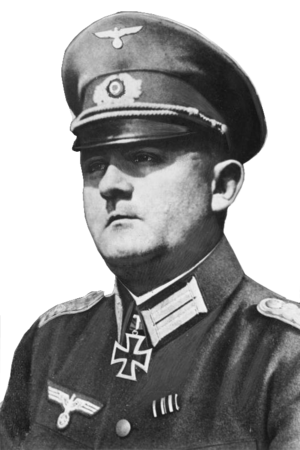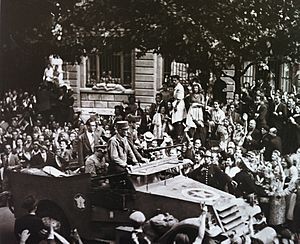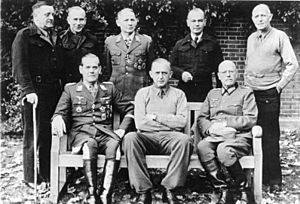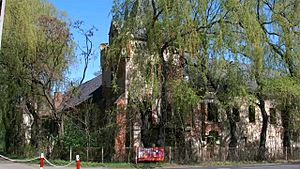Dietrich von Choltitz facts for kids
Quick facts for kids
General der Infanterie
Dietrich von Choltitz
|
|
|---|---|

Choltitz in 1940 as Oberstleutnant
|
|
| Birth name |
|
| Nickname(s) | "Saviour of Paris" |
| Born | 9 November 1894 Gräflich Wiese, German Empire (now Łąka Prudnicka, Poland) |
| Died | 5 November 1966 (aged 71) Baden-Baden, West Germany |
| Buried |
Baden-Baden cemetery
|
| Allegiance | |
| Service/ |
|
| Years of service | 1907–45 |
| Rank | |
| Commands held |
|
| Battles/wars |
|
| Awards |
|
| Spouse(s) |
Huberta von Garnier
(m. 1929) |
| Children |
|
| Signature |  |
Dietrich Hugo Hermann von Choltitz (born November 9, 1894 – died November 5, 1966) was a German general. He is often called the Saviour of Paris. He served in the German army during World War I and World War II.
Choltitz came from a noble family with a long history of military service. He joined the army when he was young. He fought on the Western Front during World War I (1914–1918). After the war, he helped Germany rebuild its armed forces.
In September 1939, World War II began with the invasion of Poland. Choltitz was part of this invasion. In May 1940, he helped capture key bridges in the Battle of Rotterdam in the Netherlands.
Choltitz is best known for his role as the last German commander of Paris in 1944. He famously did not follow Adolf Hitler's orders to destroy the city. Instead, he surrendered Paris to Free French forces on August 25, 1944. Choltitz later said he disobeyed the order because it made no military sense. He also loved Paris's history and culture. Some believe he had little control of the city due to resistance efforts.
Contents
Early Life and Army Start
Dietrich von Choltitz was born on November 9, 1894. His family lived in a castle in Gräflich Wiese, which is now Łąka Prudnicka, Poland. His father, Hans von Choltitz, was a major in the Prussian Army. Dietrich had two brothers, Hans and Job. His family was part of the nobility in Silesia.
In 1907, Dietrich von Choltitz went to the Dresden Cadet School. This was a military school for young officers.
World War I Experience
Just before World War I began, Choltitz joined the Royal Saxon Army. He became an officer candidate. His unit fought on the Western Front. He took part in major battles like the First Battle of the Marne and the Battle of the Somme. Within a year, he was promoted to Leutnant (lieutenant). He also became an adjutant, helping the battalion commander.
Between the Wars
After World War I, Choltitz returned home. On August 20, 1929, he married Huberta von Garnier. They had two daughters, Maria Angelika and Anna Barbara, and a son, Timo.
He stayed in the German army, called the Reichswehr, during the time between the wars. He became a cavalry captain in 1929. In 1937, he was promoted to Major. He led a battalion of infantry soldiers. The next year, 1938, he became a lieutenant-colonel. He also took part in the German occupation of Sudetenland in 1938.
World War II: Key Battles
Invasion of Poland
In August 1939, Choltitz became the commander of the 16th Air Landing Regiment. This was in preparation for the invasion of Poland. His regiment was moved by aircraft to Łódź.
During the Battle of the Bzura, Choltitz was wounded. On September 19, his regiment captured 3,000 Polish soldiers. They also seized a lot of military equipment.
Battle of the Netherlands
In May 1940, Choltitz and his troops landed by air in Rotterdam. Their goal was to capture key bridges. The Dutch defenders fought hard. Both sides had many casualties. Choltitz's troops faced strong resistance.
During the fighting, the Germans were worried about their soldiers in Rotterdam. Choltitz was allowed to pull his men back if needed. After a bombing raid on Rotterdam, a German general was shot. German soldiers wanted to harm Dutch officers in revenge. Choltitz stepped in and stopped this from happening. His actions during the Rotterdam assault earned him the Knight's Cross of the Iron Cross. Later that year, he took command of his regiment. The next spring, he became a colonel.
Fighting in the Soviet Union
In 1941, Choltitz's regiment moved into Ukraine as part of the German invasion of the Soviet Union. They crossed the Dnieper River. By the end of October, they reached Crimea.
His regiment fought in the siege of Sevastopol. This battle was very costly for his unit. It went from 4,800 men down to only 349.
During the winter of 1941 and 1942, Choltitz had heart problems. He was promoted to Generalmajor (major general). In 1942, he became the acting commander of the 260th Infantry division. The next year, he was promoted to Generalleutnant (lieutenant general). He then led the 11th Panzer Division in the Battle of Kursk.
Western Front in 1944
In March 1944, Choltitz moved to Italy. He became a deputy commander and fought in the Battle of Anzio. In June 1944, he was transferred to the Western Front. He commanded the LXXXIV Army Corps against the Allies in Normandy.
Governor of Paris

On August 1, 1944, Choltitz was promoted to General der Infanterie. On August 7, he became the military governor of Paris. He arrived on August 8. He found he had few soldiers, only about 20,000, and they were not very motivated.
On August 15, 1944, the Paris police went on strike. On August 19, a general uprising began, led by the French Resistance. Choltitz's soldiers fought back, but they were too few. They lost control of many public buildings. Roads were blocked, and German vehicles were damaged.
With help from the Swedish consul-general, Raoul Nordling, a ceasefire was arranged on August 20. But many Resistance groups did not accept it. Skirmishes continued the next day.
On August 23, Hitler sent an order to destroy Paris. He said, "Paris must not pass into the enemy's hands, except as a field of ruins." Explosives were placed at bridges and monuments.
However, Choltitz decided not to destroy the city. On August 25, he surrendered the German forces in Paris. He surrendered to the Free French, not to the main Allied command. Because he did not carry out Hitler's order, Choltitz is often called the "Saviour of Paris."
Hitler still tried to destroy parts of the city. The German air force bombed Paris on August 26. V2 rockets were also fired from Belgium, causing damage.
Choltitz later wrote a memoir about these events. He said he disobeyed Hitler because it was pointless. He also loved the city and believed Hitler was insane. His story became the basis for the 1965 book and 1966 film, Is Paris Burning?. Some historians suggest his decision was also to ensure he would be treated better after surrendering.
Choltitz also said that Nordling convinced him to spare the city. They had meetings where they discussed limiting bloodshed and damage. This led to the release of some political prisoners.
After the War

Choltitz was held as a prisoner of war until 1947. He was kept at Trent Park in London and later at Camp Clinton in Mississippi. No specific charges were ever filed against him.
In 1956, he visited his old headquarters at the Hotel Meurice in Paris. He was recognized by the hotel staff. He asked to see his old room. After a short visit, he left to meet with Pierre Taittinger, a French politician he had met during the surrender.
Dietrich von Choltitz died on November 5, 1966. He passed away from a long-term lung illness in Baden-Baden, Germany. He was buried in the city cemetery. High-ranking French officers attended his funeral. Baden-Baden was the French headquarters in Germany after World War II.
Awards
- Iron Cross (1st Class, 2nd Class, Knight's Cross)
- German Cross
- Honour Cross of the World War
- Order of St. Henry
- Order of the Star of Romania
- Wound Badge (Silver, Gold)
- Infantry Assault Badge
- Albert Order
- Civil Order of Saxony
- Order of Michael the Brave
- Sudetenland Medal
- Crimea Shield
See also
 In Spanish: Dietrich von Choltitz para niños
In Spanish: Dietrich von Choltitz para niños






